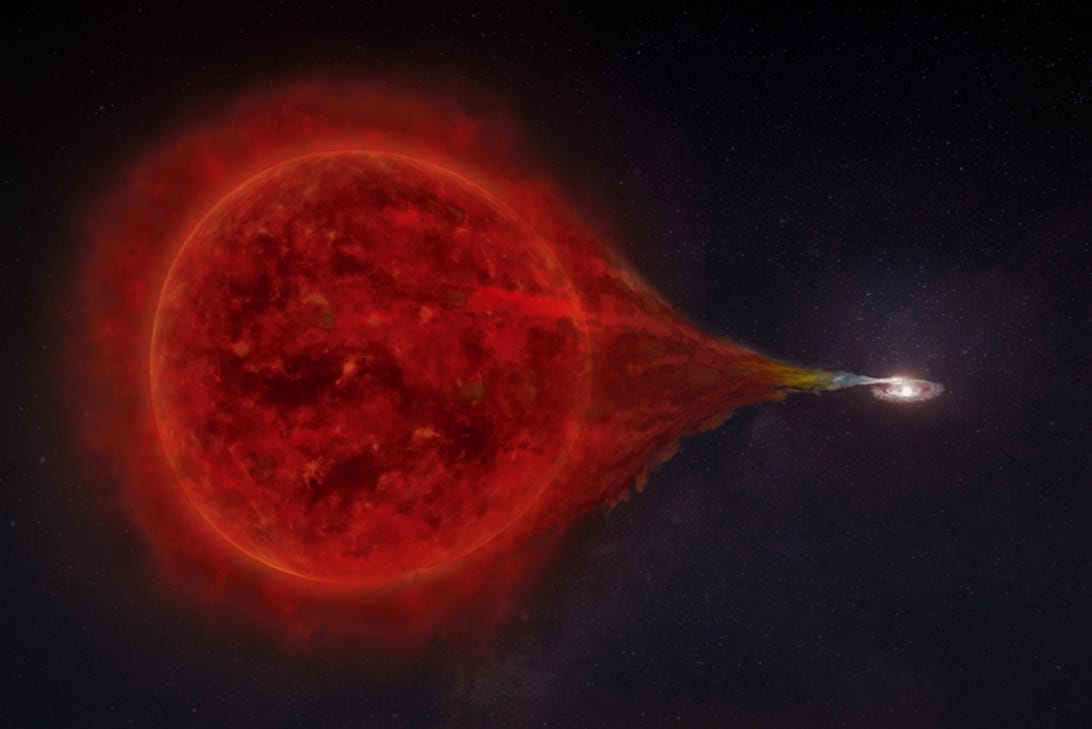There’s Been a Huge Stellar Explosion in the Serpent Bearer Constellation

On the left, you’ll see the dying red giant. On the right, is the corpse-like white dwarf.
superbossa.com/MPP
Lurking in the outer folds of deep space, some 5,000 light-years from Earth, two stars are stuck in a poetic lockstep. One is a red giant, blood-colored, colossal and dying. The other is a white dwarf, ghostly white, compact and dead. They lie in the Serpent Bearer constellation, and together they are known as RS Ophiuchi.
For decades, the burned-out corpse star has been dancing around its withering companion, feeding off its outer layer made of hydrogen. But this waltz has a timer. Every 15 years or so, the binary star system sort of overheats, igniting one of space’s most extreme events — a thunderous nova, or explosion, that releases a shower of particles that quickly accelerate to near the speed of light.
Scientists watched RS Ophiuchi reach this tipping point in 1898, 1907, 1933, 1945, 1958, 1967, 1985 and 2006.
Then, in 2021, it happened again.
According to a paper published Thursday in the journal Nature Astronomy, two Earth-based telescopes caught the dramatic eruption’s aftermath just last year. And though we don’t have a Hubble-esque image of a space-borne mushroom cloud, we might have something even more fascinating: gamma ray observations.
Gamma ray clues
Basically, when super high-energy particles, usually protons, collide, the study explains they’re expected to emit two things — a fleeting new particle and a gamma ray. These rays are among the most energetic things in the universe. A single burst of them could emanate more energy than the sun will in its entire lifetime, and they’re strong enough to travel across thousands of light-years without fading.
So, due to the ultra-high power of RS Ophiuchi’s cyclic explosion, scientists had long theorized that some hyper-fast particles flung from the system would probably bump into one another and produce those intense gamma rays. With the new study, this theory might’ve just turned to truth.
Last year, two telescopes, dubbed the MAGIC (Major Atmospheric Gamma Imaging Cherenkov) telescopes, in the Canary islands recorded some of the most energetic gamma rays ever seen coming from the red and white nova. The study researchers measured the radiation to be 250 gigaelectronvolts, which is a hundred billion times more energetic than visible light rays we’re used to.
This discovery is especially striking for two reasons.
Cosmic rays?
First off, making the find with MAGIC was a tremendous effort. The researchers had to quickly move these telescopes into place as soon as other instruments alerted them that RS Ophiuchi was about to blow. There wasn’t much room for error.
“The spectacular eruption of the RS Ophiuchi shows that the MAGIC telescopes’ fast response really pays off: It takes them no more than 30 seconds to move to a new target,” David Green, a scientist at the Max Planck Institute for Physics and co-author of the paper, said in a statement.
Second, and maybe most importantly, this discovery might help elucidate one of our universe’s biggest mysteries: The cosmic ray puzzle.
First discovered in 1912 by an Austrian physicist named Victor Hess, cosmic rays have since become an everlasting reminder of how little we know about the universe.
In a nutshell, these zippy bits are extraordinarily energetic atom fragments that rain down onto Earth at the speed of light and are known to interfere with our human technology, like satellites or radio communications. But there’s a catch: Scientists can see them, measure them and study them, but they still don’t have clarity on where they come from.
However, because the MAGIC telescopes successfully found gamma rays, which are associated with cosmic rays, coming from RS Ophiuchi, “this also makes nova outbursts a source of cosmic rays,” Green said, though emphasizing that the nova’s gamma rays likely act as cosmic rays only in RS Ophiuchi’s immediate vicinity, which is very far away from our planet.
But, in the future, the team intends to keep using MAGIC and see whether the telescopes can pick up gamma rays stemming from violent events much closer to Earth.
For all the latest world News Click Here

